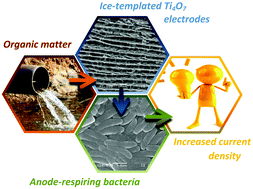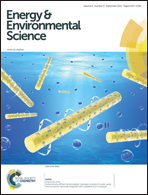New ceramic electrodes allow reaching the target current density in bioelectrochemical systems†
Abstract
Whereas most of the studies conducted nowadays to boost electrode performance in bioelectrochemical systems (BES) are focused on carbonaceous scaffolds, in this study we demonstrate that ice-templated titanium-based ceramics (ITTC) can provide a new alternative for this purpose. We combined the chemistry of titanium suboxides (Ti4O7) with an ice-templating technique (ISISA) to produce electrically conducting and highly porous (88% porosity) 3D architectures. The ITTC platforms were characterized by strongly aligned macrochannels that provided a direct path for substrate supply under a flow-through configuration, while supporting the growth of electroactive Geobacter sulfurreducens biofilms. This new electrode material is demonstrated to outperform graphite when used as an anode in bioelectrochemical reactors, providing volumetric current densities of 9500 A m−3, equating to projected current densities of 128.7 A m−2 and maximum power densities of 1.9 kW m−3. The performance of the ITTC scaffolds levels that of any of the available materials on the current state of research. The presented alternative may lead to the start of a branch into the exploration of conducting ITTC materials in the growing area of bioelectrochemical technologies.


 Please wait while we load your content...
Please wait while we load your content...